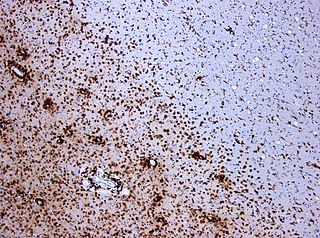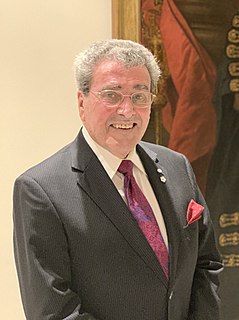Related Research Articles

Neurology is a branch of medicine dealing with disorders of the nervous system. Neurology deals with the diagnosis and treatment of all categories of conditions and disease involving the central and peripheral nervous systems, including their coverings, blood vessels, and all effector tissue, such as muscle. Neurological practice relies heavily on the field of neuroscience, the scientific study of the nervous system.

Multiple sclerosis (MS), also known as encephalomyelitis disseminata, is the most common demyelinating disease, in which the insulating covers of nerve cells in the brain and spinal cord are damaged. This damage disrupts the ability of parts of the nervous system to transmit signals, resulting in a range of signs and symptoms, including physical, mental, and sometimes psychiatric problems. Specific symptoms can include double vision, blindness in one eye, muscle weakness, and trouble with sensation or coordination. MS takes several forms, with new symptoms either occurring in isolated attacks or building up over time. Between attacks, symptoms may disappear completely, although permanent neurological problems often remain, especially as the disease advances.

Interferon beta-1a is a cytokine in the interferon family used to treat multiple sclerosis (MS). It is produced by mammalian cells, while interferon beta-1b is produced in modified E. coli. Some research indicates that interferon injections may result in an 18–38% reduction in the rate of MS relapses.
Guido Calabresi is an Italian-born American legal scholar and Senior United States Circuit Judge of the United States Court of Appeals for the Second Circuit. He is a former Dean of Yale Law School, where he has been a professor since 1959. Calabresi is considered, along with Ronald Coase and Richard Posner, a founder of the field of law and economics.

The McDonald criteria are diagnostic criteria for multiple sclerosis (MS). These criteria are named after neurologist W. Ian McDonald who directed an international panel in association with the National Multiple Sclerosis Society (NMSS) of America and recommended revised diagnostic criteria for MS in April 2001. These new criteria intended to replace the Poser criteria and the older Schumacher criteria. They have undergone revisions in 2005, 2010 and 2017.
Aaron E. Miller, M.D. is an American neurologist, the first Chairman of the Multiple Sclerosis section of the American Academy of Neurology (AAN) and recognized as a multiple sclerosis clinician.
Fred D. Lublin is an American neurologist and an authority on the treatment of multiple sclerosis. Along with colleagues at the National Multiple Sclerosis Society, his work redefined the clinical course definitions of MS.
Jeffrey Alan Cohen is an American neurologist specializing in multiple sclerosis and Director of Experimental Neurotherapeutics at the Cleveland Clinic Mellen Center for Multiple Sclerosis.
Richard T. Johnson was a physician and scientist at the Johns Hopkins University School of Medicine. Johnson was a faculty member in the Department of Neurology since its inception in 1969 and was the former head of the department. His research into the effects of viruses on the central nervous system has been published in over 300 scientific articles, and Johnson was both a journal and book editor and the author of an influential textbook, Viral Infections of the Nervous System.

Stephen L. Hauser is a professor of the Department of Neurology at the University of California, San Francisco (UCSF). His work specializes on immune mechanisms and multiple sclerosis (MS). He has contributed to the establishment of consortia that have identified more than 50 gene variants that contribute to MS risk.
The Mischer Neuroscience Institute is a combined research and education effort between the Vivian L. Smith Department of Neurosurgery and the Department of Neurology at McGovern Medical School at UTHealth and Memorial Hermann Hospital. Located in Houston, the Institute draws patients from around the world for specialized treatment of diseases of the brain and spine. It was the first center in Texas and one of only a few institutions in the country to fully integrate neurology, neurosurgery, neuroradiology, spine surgery, pain medicine and neurorehabilitation.

John Francis Kurtzke was a neuroepidemiologist and Professor of Neurology at Georgetown University who is best known for his creation of the Expanded Disability Status Scale and for his research on multiple sclerosis (MS). After graduating from Cornell University Medical College in 1952, Dr. Kurtzke started his career in the field of Neurology as Chief of the Neurology Service at the Veteran’s Affairs (VA) Medical Centers in Coatesville, Pennsylvania, from 1956 to 1963, and then in Washington, DC, from 1963 to 1995, where he became Professor of Neurology at Georgetown University. At the time of his death, he held the title of Professor Emeritus at Georgetown University.

Thomas John "Jock" Murray is a Canadian neurologist, medical historian and author.

David A. Hafler is an American neurologist. He is the Edgerly Professor and chairman of the department of Neurology at the Yale School of Medicine. He is known for his work in immunity, genetics, and multiple sclerosis. In 2018 he was elected to the National Academy of Medicine.

Howard L. Weiner is an American neurologist, neuroscientist and immunologist who is also a writer and filmmaker. He performs clinical and basic research focused on multiple sclerosis (MS) and other neurologic diseases such as Alzheimer’s Disease and Lou Gehrig’s Disease (ALS). His work also focuses on autoimmune diseases such as diabetes. Weiner is the Robert L. Kroc Professor of Neurology at Harvard Medical School, director of the Brigham MS Center at the Brigham and Women’s Hospital and co-director of the Ann Romney Center for Neurologic Diseases established in 2014, at the Brigham and Women’s Hospital in Boston, Massachusetts.
There are several ways for pharmaceuticals for treating multiple sclerosis (MS) to reach the market.

Stephen George Waxman is an American neurologist and neuroscientist. He served as Chairman of the Department of Neurology at Yale School of Medicine, and Neurologist-in-Chief at Yale-New Haven Hospital from 1986 until 2009. As of 2018, he is the Bridget Flaherty Professor of Neurology, Neurobiology, and Pharmacology at Yale University. He founded the Yale University Neuroscience & Regeneration Research Center in 1988 and is its Director. He previously held faculty positions at Harvard Medical School, MIT, and Stanford Medical School. He is also visiting professor at University College London. He is the editor-in-chief of The Neuroscientist and Neuroscience Letters.
Radiologically isolated syndrome (RIS) is a clinical situation in which a person has white matter lesions suggestive of multiple sclerosis (MS), as shown on an MRI scan that was done for reasons unrelated to MS symptoms. The nerve lesions in these people show dissemination in space with an otherwise normal neurological examination and without historical accounts of typical MS symptoms.
Anne Cross is an American neurologist and neuroimmunologist and the Section Head of Neuroimmunology at Washington University School of Medicine in St. Louis, Missouri. Cross holds the Manny and Rosalyn Rosenthal–Dr. John L. Trotter Endowed Chair in Neuroimmunology at WUSTL School of Medicine and co-directs the John L Trotter Multiple Sclerosis Clinic at Barnes-Jewish Hospital. Cross is a leader in the field of neuroimmunology and was the first to discover the role of B cells in the pathogenesis of multiple sclerosis in animals and then in humans. Cross now develops novel imaging techniques to observe inflammation and demyelination in the central nervous systems of MS patients for diagnosis and disease management.
Frederik Barkhof is a neuroradiologist. He led the development of the Barkhof Criteria for using MRI findings to predict conversion to clinically definite multiple sclerosis.
References
- 1 2 3 4 Calabresi, Peter. "Curriculum Vitae of Peter Calabresi" (PDF).
- ↑ Rosner, Louis; Ross, Shelley (2008-03-11). Multiple Sclerosis: New Hope and Practical Advice for People with MS and Their Families. Simon and Schuster. pp. 278–. ISBN 9781416565857.
- ↑ Schiffman, Fred (2006). "PAUL CALABRESI". Transactions of the American Clinical and Climatological Association. 117: xlvii–l. ISSN 0065-7778. PMC 1500936 . PMID 18528459.